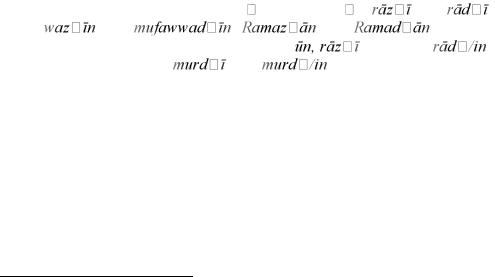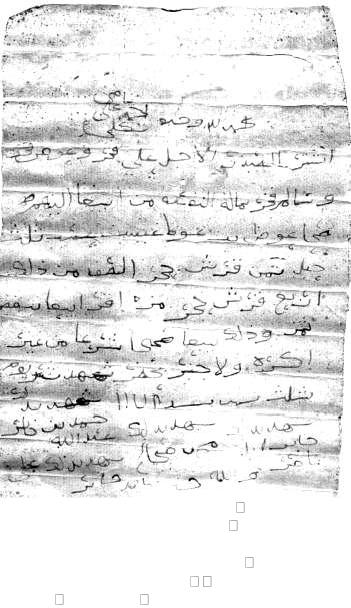
Naumkin_V_-_Islam_i_musulmane_kultura_i_politika_2008
.pdfречиями между различными европейскими и региональными державами, пытаясь небезрезультатно обратить их интересы и стремления ослабить или не допустить усиления влияния той или иной стороны в свою пользу. Это относится, в частности, к его дипломатической игре с Англией и СССР, противоречия между которыми позволили королю получить необходимую ему для решения внутренних проблем передышку и добиться максимально возможного обеспечения своих интересов в двусторонних отношениях с этими державами.
В то же время нельзя рассматривать отношения Ибн Сауда с Россией в то время лишь как часть его международной игры. Несмотря на неприязнь, испытываемую Ибн Саудом к идеологии, господствовавшей тогда в Советском государстве, он правильно почувствовал симпатию, которую оно питало к его стремлению создать в Аравии мощное централизованное государство и проводить не зависимый от колониальных держав курс, рассматривал его как источник поддержки.
Выверенный дипломатический маневр прослеживался и в эволюции отношений Ибн Сауда с другими иностранными державами на Западе и на Востоке. Ибн Сауд сочетал дипломатический прессинг с готовностью идти на компромиссы, продиктованной его ограниченными возможностями. Одним из главных ограничителей для его действий на внешнеполитической арене во второй половине 20-х годов была еще неурегулированная ситуация внутри государства и сопротивление, которое встречала организаторская деятельность короля со стороны ряда групп, пытающихся действовать сепаратистски или автономно, а в отдельных случаях и под воздействием внешних сил. Однако и здесь, как показывают материалы из российского дипломатического архива, Ибн Сауд в тяжелых экономических условиях донефтяной эпохи сумел добиться впечатляющих успехов в объединении страны в единое целое.
199
THE TRADITIONAL INSTITUTIONS IN UPPER YĀFI‘ (YEMEN),
18TH – 20TH CENTURIES
(расширенный англоязычный вариант статьи «Традиционные институты в Верхнем Яфи», опубликованной на русском языке в книге:
Государственная власть и общественно-политические структуры в арабских странах: история и современность
/Москва: Главная редакция восточной литературы, 1984, с. 141–156/, – был представлен в качестве доклада на ежегодной конференции
Британского общества ближневосточных исследований, г. Эдинбург, 2001 г.)
The traditional social, socio-political, legal and ideological institutions associated with clan and tribal organisation or its rudiments have persisted in the Yemen over a protracted period right down to the present.
Mountain regions, to which geographically long-isolated Upper
Yāfi‘ belongs, are marked by an especially strong persistence of traditional structures and institutions that date back to antiquity or the Middle Ages.
Yāfi‘ is the name of a group of tribes and the area of their settl e- ment extending from the mountain regions in the north -west of Abyan province (former South Yemen) to the littoral regions in the south of that province. Historically, Yāfi‛ was divided into Upper and Lower Yāfi‛. The mountain regions of the north of the region formed part of Upper Yāfi‛, and only partly of Lower Yāfi‛. The mountain dweller s had long since been engaged in farming, using streams of rainwater flowing down mountain slopes and valleys for irrigation, as well as in goat-breeding.
225

The Yāfi‘ī mountain dwellers were known for their strength, e n- durance in, and perfect mastery of wielding arms. The lack of land resources spurred them into migrations. From about the beginning of the sixteenth century, the Yāfi‘ tribes began to settle in certain areas of
ad |
ramawt, east of Yafi‘.1 The increased influence of the Yafi‘is |
was |
facilitated by the fact that a ruler of Āl athīrī , Badr Bū |
T uwayriq, enrolled the Yafi‘is (along with the Zaydis from the north of the Yemen and the Turks) into his army. The Yāfi‘is from the Āl asād succeeded in establishing their rule in a part of H ad ramawt and form a dynasty there. In the eighteenth century Yafi‘ mercena r- ies began to serve as part of the household troops of the nizam of Hyderabad, India, where they reached high ranks in the military hie r- archy and owned land . In the middle of the nineteenth c entury, a rich Yāfi‘ feudal lord, ‘Umar b.‘Awa b. ‘Abdallāh who lived in I n- dia and rose to the highest jemadar (gama‘dar) rank at court of the Hyderabad nizam helped his fellow Qu‘at ī tribesmen – of one of the Yāfi‘ tribes inhabiting Wādī ‘Amd – first to capture the town of Shibām and then to expand their domains. ‘Umar founded the Qu‘ayt ī dynasty , while the Qu‘ayt ī sultanate soon subdued the greater part of H ad ramawt,2 a dynasty which held out there till 1967. Harold Ingrams reports that besides the Yāfi‘ tribes long since settled there, mercenaries from Yāfi‘ continued to arrive for se rvice
in ad ramawt as late as the 1930s.3
The Yāfi‘is (predominantly mountain dwellers) also travelled to acquire wealth abroad, including the Arab countries, Indon esia, East Africa, the Horn of Africa and Britain.
During the medieval times, mountain Yāfi‘, owing to its isolated location, depended but little on central authority (while formally obeying various rulers), and retained its separate identity. The first Turkish occupation of Yemen in the sixteenth-seventeenth centuries left this region virtually unchanged. Natives of Yāfi‘ played an em i- nent role in political life of the Yemen. Thus in 1630 –1644 Amīr
usayn al-Yāfi‘ī ruled over the greater part of southern area of the
1 |
Immigrants from the Yāfi‘ tribes penetrated into a ramawt even earlier. It is evident that |
|
the town of Mukallā |
was founded in the year 1035 [AD 1625] by a native of Yāfi‘, |
|
|
|
Reisen in Süd-Arabien Mahraland und Ha- |
dramut (Wien, 1913), p. 12. |
||
2 |
- |
Adwār al-tār h al- a ram , 2 vols, (Jeddah, Mukalla, 1966), II, |
|
||
195. |
|
|
3 |
Harold Ingrams, Arabia and the Isles (London, 1966), 300. |
|
226

Yemen. After him virtually all the regions of the south came under control of the Zaydi imam of San‘ā’. But already during the rule of imam Mu‘ayyad Muh ammad (1681–1686), the Yafi‘i tribes had expelled his governor-general; however, later the imam managed to reestablish his rule over the region. But the Yāfi‘is rebelled once again, regaining their complete independence by the early eighteenth century. Since then, sultans and shaikhs from local tribes came to rule the area. In the mid-nineteenth century, Britain, after conquering Aden in 1839, gradually imposed its protectorate over the sultanates, amirates and shaikhdoms of the south, Yafi‘ included. The Western
Aden Protectorate was formed in 1937 and came to include, among others, the Sultanates of Upper and Lower Yafi‘ as well as five
smaller shaikhdoms of Upper Yāfi‘: Bu‘sī, al -Muflah |
ī, a ramī, |
|
abī, and al-Mawsat |
ah. |
|
Time and time again, the population of the region rose against the colonial authorities. After suppressing one of the waves of that struggle in 1944–45, the colonial administrators compelled the rulers of the WAP, Upper Yāfi‘ included, to sign an agreement whereby the governor of the colony of Aden obtained the right to interfere in their internal affairs. The Yafi‘is took part in the armed liberation movement of 1963–1967 that culminated in the winning of South Yemeni independence, and after the unification of the two parts of Yemen in 1990 the region became part of the single Yemen Republic.
The socio-economic and political system of Upper Yāfi‘ saw little change over a long period right down to the 1970s, 4 keeping its peculiar features intact. In the socio -economic field, this was manifested in the absence of large-scale land property, the predominance of small-scale property, the dominance of a patriarchal economy, limited use of hired labour, the prevalence of lease and mortgage of land, tribal division of labour, low productivity and slight social di f- ferentiation. In the political field, these peculiar features were m anifested in the absence of a strong central authority, fragmentation and frequent internecine feuds, the continued leading role of clan and tribal organisation and the dominance of custom and customary law. All these factors, along with lack of land, natural fragmentation of agricultural property, harsh climatic conditions, geographic isolation, and overpopulation conditioned the stagnation of the region’s ec o- nomic and political development, which was also fostered first by the
4 Slow modernisation started in the region only a few years after independence.
227

imam’s theocratic regime, then by that of the protectorate, as well as by the political fragmentation of the whole region.
In fact, Upper Yāfi‘ lacked cities or urban settlements. The Yāfi‘is lived in clans forming part of tribes which, in their turn, combined into tribal unions or confederations. Up to the present time, each village in Upper Yafi‘ was a settlement of a certai n clan or tribe. There existed a tribal division of labour, whereby each tribe or its section had a traditional occupation. There were tribes of far m- ers, potters, blacksmiths, stonemasons, carpenters, dyers, musicians, brushwood collectors, witch-doctors and exorcists, and so forth.
R.B.Serjeant gave a brilliant description of the Yāfi‘ tribes in his Yāfi‘ Zaydīs, Āl Bū Bakr b. Sālim and others: tribes and sa y- yids, On Both Sides of Mandab – Ethiopian, South Arabic and Islamic Studies presented to Oscar Lofgren on his ninetieth birthday 13 May 1988 by colleagues and friends, eds ulla Ehrensvard and Christopher Toll, Swedish Research Institute in Istanbul, Transa c- tions vol.2, Stockholm, 1989, 83–107. am ah ‘Alī Luqmān men-
tions in Tār ħ al-Qabā’il al-Yamaniyyah (g.1, |
al-Yaman al- |
||||
Ganūbiyyah, Dār alalimah, |
San‘ā’, 1985, 203–210), that |
the |
|||
tribal |
confederations of Upper |
Yāfi‘ |
are the following: 1/ ahl |
al- |
|
shay |
h ‘Al , 2/ahl al-h ad, 3/ ahl wād |
alamrā’, 4/al- |
, |
||
5/al- |
, 6/al-bu‘si, 7/al- a |
rami. The region of |
ahl al- |
|
|
in the past was bearing the name of al -‘Ināq , one part of it was located in the south, another – in the north of the Yemen. The
southern part covered al-Bu‘si, |
alubī, al- |
- |
ma |
ātib (sing. maktab – big tribal |
|
group), each of them divided into smaller tribes. For example, ahl bā ‘abbād, who are mentioned in some of our documents, are a subdivision of alawr i tribe, which belongs to maktab al-bu‘ s .
Tradition largely defined the Yāfi‘is’ economic activity. A cen tu- ries-accumulated experience was required for terraced farming: to practice it, one has to make an optimal choice in the arrangement of terraces, to assemble from stone the walls of required height, to bring earth from the valley if necessary, etc. Even today, earth is handled mostly by hand, with the help of an iron hook called an arah. The agricultural calender was based on a position of the stars. The mou n- tain dwellers kept count of time in terms of ten -day periods, with a definite pattern of the stars corresponding to each and it was in a c- cordance with this pattern that the time-limits for crop cultivation were fixed.
228

The tribes paid the tithe (‘ušr) to the sultan or shaikh who had the rights of a suzerain, but some tribes were exempted from tax payment. The well-to-do of the population included ‘small shaikhs’ (or ‘āqils, mans abs) – heads of clans and tribes, and ‘great shaikhs’
– heads of confederations, as well as tradesmen and owners of gai n- ful plots of land where cash crops – coffee, qāt as well as cereals – were mostly grown and where hired labour was partly employed, but the workers were, as a rule, members of the patriarchal family and fellow tribesmen.
The system of relations between rulers (sultans, shaikhs, ‘āqils, mans abs) and tribes bore a traditional character, while retaining certain elements of clan and tribal democracy. This was manifested in the very state organisation of the sultanate and the shaikhdoms, where the principal role was played by the principle of suzerainty and recognition by some tribes of the domination of others, and in the order of power succession, where elements of a rotation system were maintained. The Qu‘ayt ī sultan, ‘Awad b. ‘Umar, laid down the following order of succession: his son Ghalib, from him to anot h- er son ‘Umar, from him to Ghalib’s son, S ālih , from him to the son of ‘Umar, and so forth, so that power would by turns pass on to members of the two branches of the clan.5
The migration of a considerable number of the population (ove r- whelmingly male) to other regions of South Arabia and other cou n- tries with subsequent return thereof left the pattern of socio - economic and socio-political relations in the region unaffected. But this migration ensured the flow of revenues needed for the Yāfi‘is’ existence, as the population could not feed itself without it. Capital accumulated by the Yāfi‘is in emigration was mostly used unprodu c- tively in line with time-honoured traditions. The Yāfi‘is returning from abroad were building sumptuous three or four -storey houses made of stone,6 got married (dowry was here very high), or married off their children, arranging costly wedding ceremonies. A lot of money was spent on the acquisition of arms and munitions.
5Ingrams, ibid., 21.
6The traditional building art was extremely well developed in Upper Yafi‘. The skill of a stonecutter was cultivated in certain tribes and descended from father to son. In the 1970s, when the author was performing field research in the region, labour was and is still very highly remunerated (in ther mid-1970s a skilled stonecutter earned up to 30 dollars and more per day, which far exceeded the earnings of the inhabitants of the republic).
229

Upper Yāfi‘ tribes were often locked in deadly feud with each other. Mountain dwellers strove to build houses as high above as possible: a man who lived in a high position felt more secure and e n- joyed an advantage over his lower neighbour in case of conflic t. The sultans, shaikhs and ‘āqils built their houses in the highest places. To guard landed property, cylindrical watchtowers (sing. nūbah) were erected, from where their owners could fire their guns. Wells were protected with stone walls so that a person coming for water could not be fired upon. There arose even a specific distinction between the the ‘upper’ (‘ulyān) and ‘lower’ people (suflān).
Blood feud was common, as a result of which intertribal conflicts at times would not die away for decades. Disputes over land often erupted in conditions of land hunger and overpopulation. Therefore the question of delimitation of agricultural plots and division of i n- heritance were of an extreme importance. In the resolution of these questions, as well as in the reconciliation of tribes and the regulation of intertribal relations, the role of shaikhs was prominent – the bearers of traditions of customary law acting as arbiters or witnesses in the process of drafting documents, and sayyids 7 – literate people, proficient in Islamic law, performing judicial functions on the basis of the precepts of the shar ‘ah and norms of customary law. Also they often acted as qād s). Preserved was the old-time tradition of markets that were arranged on certain days of the week in a definite place. On these days it was forbidden to wage hostilities and all clashes were halted.
The women in Yāfi‘ took an active part in economic activity on a par with the men, a fact noted long ago by medieval Arab authors. U n- til the last years of Islamisation, the women never wore a veil, enjoying much greater freedom than was the case in other regions of the Yemen. Among the peculiar customs of mountain women is a custom to make themselves up with bright mineral dye-stuffs, which they themselves explain not only by the need to adorn themselves but also by the desire to protect facial skin from exposure to extremely dry mountain air (the most popular mineral dyer is wars of – read colour).
In Upper Yāfi‘, the tribal common law (‘urf), which frequently clashed with the norms of the shar ‘ah, proving superior to it, has always been the main regulator of relations between tribes, clans, families and individuals. This, in particular, has been manife sted
7 The Muslim religious aristocracy tracing its lineage to Prophet Mu
230
in the pattern of inheritance of property in families. Plots of land and houses were divided only between the sons, the daughters ge t- ting nothing. According to the explanation of the informants, this is connected to the extreme scarcity of land resour ces and constant conflicts between tribes over land. A daughter may marry a man from another tribe and he will become the proprietor of a portion of land of the family from which this daughter has come. Then he may divorce her and the land will fall into a nother’s hands, which in the past might provoke a long and bloody conflict. Thus the deprivation of daughters of a share of the inheritance has helped to preserve the property of families and tribes, their survival and the maintenance of inter-tribal peace. As one of the informants explained, otherwise a poor or crafty bridegroom could marry on purpose, in order to get hold of another’s property. However, a c- cording to this norm of common law, brothers were obliged to keep the sisters completely and give the m a place in the house until they married. Brothers are annually obliged to make presents – clothes, food and/or household goods to married sisters. This kind of annual allowance was called hadiyyah wa qadiyyah. In case if the sister got divorced, she had the right to return into the house of her brothers and they were again obliged to keep her. The norms of ‘urf were so rigidly observed that if brothers had no means to give the sisters hadiyyah wa qadiyyah, they found themselves forced to mortgage their land. Such a situation is illustrated by Document No.10. Having earned enough money to pay to the one who had taken their land in mortgage all he has spent on hadiyyah wa qadiyyah, the brothers further had a chance to get the land back, otherwise that man reserved it. All the subsequent property relations between those people were also regulated by the norms of common law, which were attended to by the shaykhs (not the shaykhs of tribes but religious ones).
The Yāfi‘ī mountain dwellers retain many other ancient cu s- toms and remnants of pre-Islamic beliefs. Not far from Lab‘ūs (this small settlement was turned into the capital of Upper Yāfi‘ by the leftist government of the People’s Republic of South Ye m- en in order to undermine the role of the traditional centres of tribal authority, the name of this settlement means Bu‘sis ) there exists a mausoleum of the holy bull (al-wal al-thawr), which is a relic of an old pastoral cult. It was customary to perform a pilg rimage ( iyārah) to the grave of the bull similar to the graves of Muslim
231

saints. Women asked it to fulfil their wishes. Certain rare traces of Judaism common in some parts of the Yemen prior to Islam have been preserved in the region. During the Middle Ag es, Yāfi‘ was known as one of the centres of Carmathism in Arabia. Individual followers of the Islamic sect of Ahl al -Haqīqah have still remain there to this day.
Family archives of Yāfi‘īs containing various documents may serve as one of the most important sources for the history of this highly interesting region of the Yemen. In the course of fieldwork carried out by the author in Upper Yafi‘, he was presented with a number of documents from family archives dating from different post -medieval periods. These allow a preliminary appraisal and an attempt at systematisation. The documents are written in ink on paper. Their interpretation is extremely difficult as they contain many of grammatical mistakes. Local dialect words are used and diacritics are not everywhere included. A number of words and even phrases are illegible, there are gaps, as well as page breaks, and other defects. Here is one of the examples of the influence of the spoken dialects of Upper Yāfi‘. In these dialects q is pronounced as gh. In special cases, when it is necessary to distinguish q and gh, for instance in personal names, gh is pronounced as‘: ‘alib instead of Ghalib. In our documents q is sometimes replaced by gh. J is
always pronounced as g (ğ). |
|
|
|
|
|
|
Another example is the use of z instead of d |
( |
, not |
; |
|||
mufaw |
, not |
; |
, not |
|
). It can |
|
be seen here the use of ___ n instead of |
|
instead of |
/ |
|||
( also wād , not wād/in/; |
, not |
/; masāq , not masāq/in/ |
||||
etc.). Ibn is found in the place of bin between parts of the personal name;
‘awayid instead of ‘awa’id, bāyi‘ instead of bā’i‘ ; alif mamdūdah is replacing alif ma sūrah in ilayya, ‘alayya etc. The earliest of the documents cited below is dated 1169 [AD 1755] and the latest 1333 [AD 1914] (we also have at our dispasal documents from earlier periods starting from 1675).
The first document is a deed of purchase (sijill bay‘).8 The documents, as a rule, speak of sale and purchase of landed estates, also arms, implements, or an entire property. Let us cite some documents by way of example. The greater part of them was acquired from a
8 We have chosen an arbitrary procedure of enumeration. Although deeds of purchase constitute the bulk of documents at our disposal, we cannot pass judgement on the representative character of our collection.
232

single family archive of a clan living in the village of al - adīdah, from the tribe of alawtharī, tribal confederation Bin Naqīb, in
1976. Another part came from the dwellers of villages in the vicinity of Lab‘ūs.
Document No 1
|
Qād |
ī |
Glory to Allah alone! |
Ah |
mad ‘Alī |
|
al-Thaklī |
|
The most esteemed ‘Alī Fakhr and ‘Awad Fakhr have purchased a plot of ‘atar land of one-third of a h abl for eight hard qurūsh, belonging to ‘Awad b. ‘Awad who properly sold it to them. Half of the above sum, four hard qurūsh, was paid at sale (?). The sale is proper and legal, made without coercion and duress, negotiated on Tuesday in
233
